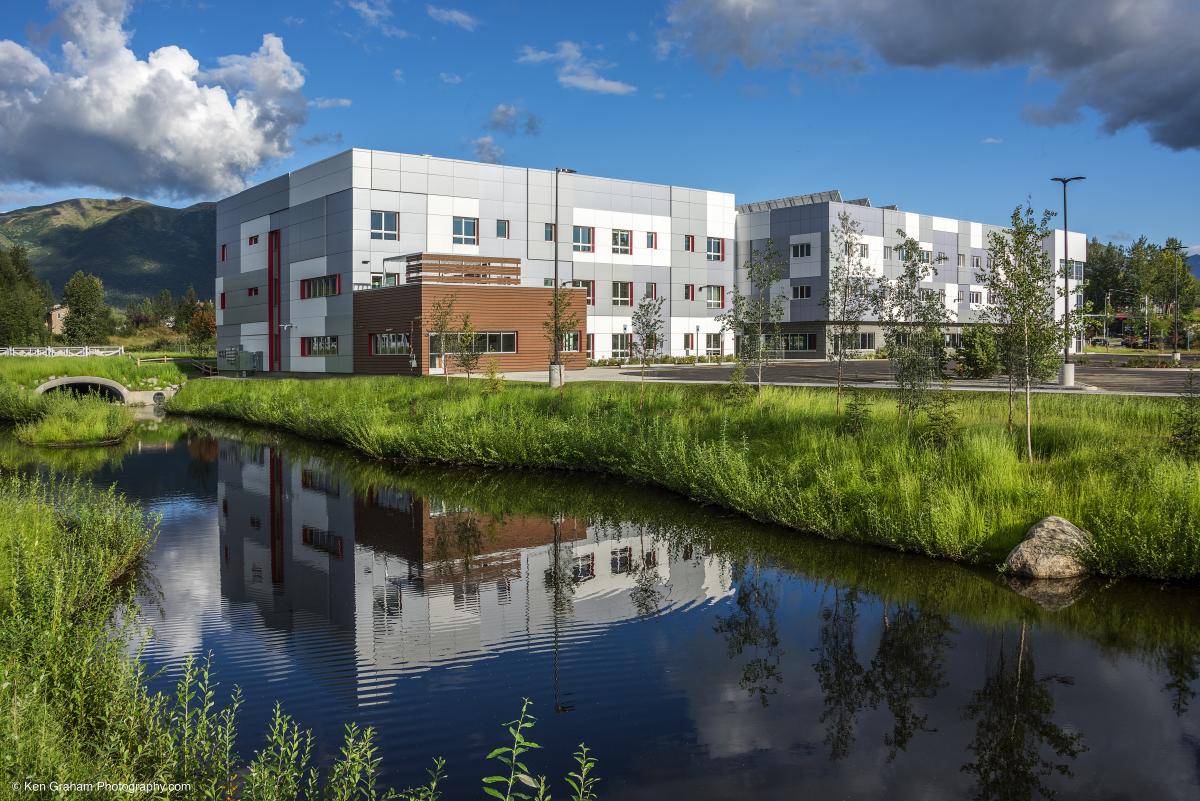Partnering to Create Success through Housing Grants in Alaska
Editor's Note: This is part of our series focusing on the winners of the 2018 Secretary’s Award for Public-Philanthropic Partnerships.
 |
|
The Creekview Plaza housing development in Anchorage, Alaska |
For a decade Rasmuson Foundation has worked alongside Alaska Housing Finance Corp. to address vital housing needs for specific groups: working families, rural professionals, seniors and those at the very edge of society. This work is unusual: these two organizations don’t know any other partnership in the country in which a private foundation and a public corporation jointly plan and fund specific housing projects.
As a housing crisis loomed in 2015, the potential power of this partnership was underscored. The State of Alaska was – and still is – experiencing a budget crisis due to declining oil production and lower oil prices. Lawmakers have been in a budget-cutting mode, and three years ago marked the state’s rural professional housing program for elimination.
This program, which had already taken a significant hit, develops housing for teachers, healthcare workers and public safety officers in remote villages that often are home to just 100 to 300 residents. Most of these villages are off the road system, accessible only by small plane, snow-machine or boat.
In rural Alaska, homes are crowded with families living with families, and ten or more people may share one small place. With that type of situation, there typically are no rentals available for teachers, health aides and village public safety officers. Building more housing is a challenge, as rural housing developments are too small and Bush Alaska villages can be too remote for tax credit financing, private financing or other funding beyond Native American block grants.
Rasmuson Foundation entered that climate with a challenge grant, shifting the terms for what it had already pledged to keep the state as a funder. The Foundation agreed to put up $1.95 million — if the state put money into the Alaska Housing Finance Corp. rural housing program. This strong advocacy diverted the political will from program elimination to program support. Anna MacKinnon, co-chairwoman of the Alaska Senate Finance Committee, cited Rasmuson Foundation support in a key committee meeting in 2016, and since then, the state legislature has provided $8 million in matching grants against that $1.95 million award. In an era where the state has zeroed out almost all discretionary funding, the Foundation’s challenge saved what is officially known as the Teacher, Health Professional and Public Safety Housing Program.
The very next year, Rasmuson Foundation built on the success of the housing grant for rural professionals. It once again challenged the state, this time to restore a senior housing program that had been shut down.
“Over the past decade, the Rasmuson Foundation’s partnership with Alaska Housing Finance Corporation has done more than simply invest dollars in developments: it has single-handedly saved two essential development programs from elimination,” said Bryan Butcher, executive director of AHFC.
With the senior housing program, Rasmuson Foundation put in $1.75 million, matched by the state over two years with $2.75 million.
At that point, the framework was in place but the main question remained: how do we make it last? Rasmuson Foundation then guided a shift in the housing funding model from construction grants to one that combines grants and a revolving loan fund. Revenue generated goes back into the pool to fund future developments. This is an approach for sustainability.
The partnership itself is innovative. Other foundations may offer grants to an intermediary that then works with a housing corporation. In Alaska, foundations are at the table to help guide projects. This gives organizations the confidence to put money directly into developments. In addition, foundations use their program-related investment portfolio to issue low-interest loans paired with AHFC traditional loans and commercial debt. The action buys down construction costs and helps further advance projects.
When the initial three years of funding for rural professional housing ran out, Rasmuson Foundation put in $1 million more. In return, this generated an additional $1,750,000 from the Alaska Legislature this legislative session for the rural effort. Lawmakers also designated $1 million more for the once-dead senior housing program.
The entire concept can be mirrored anywhere, yet in the past foundations have shied away from partnering with state agencies.
One lesson is that foundations should not fear working directly with government but rather can embrace this strategy to open doors. Show political leaders they can keep vital programs with foundation support. Shape project financing in new ways. Give foundations confidence to participate, with a seat at the table.
Come to Alaska. There are public and private partners here who would be glad to show you what has been done.



